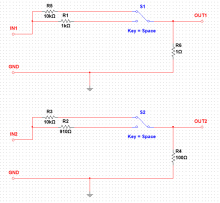Initial tests and calibration
After supplying the power the unit worked right away. Checking voltages at test points showed the correct values. This part went smoothly, so I left the unit to warm up for half an hour.
RMS to DC block is the first one in the calibration sequence. I suggest that you use a precise bench multimeter in order to calibrate the converter correctly. In the calibration process you will need to supply test signals. I used Analog Disovery 2 as a signal generator. Various BNC to banana adapters came in very handy as well.
For the next steps it is suggested to use a 60 dB attenuator, so I decided to build a dedicated box.
Switchable attenuator box
I thought that it may be useful to have a box that can pad down the level of the signal by the preset amount. I ended up making two sections of the pad box: one is a 80/60 dB pad with 1R output impedance, another is 40/20 dB pad with 100R output impedance. Here's the schematic.
The top part is 80/60 dB section, the bottom part is 40/20 dB section. Here's the circuit built into a small box:
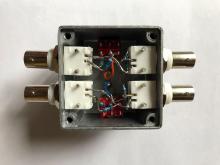 |
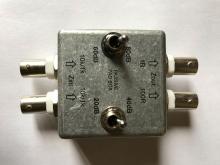 |
1% resistors gave roughly 0.2 dB deviation which is fine with me. Let's make a quick check with the QA401 analyzer to make sure that the box performs properly. We'll need a low output impedance signal generator. For this we will use Analog Discovery 2. I set the output jumper of the AD2 signal generator to 0 Ohms and fed it directly into the QA401 input. I adjusted AD2 output level so that I read 0dBV peak at the QA401 (it ended up at 1.52V peak-to-peak with my particular unit).
After that I inserted the attenuator and set it for 60 and 80 dB. Here's what I got:
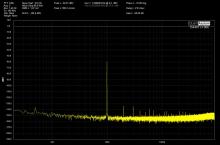 |
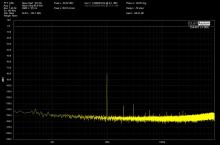 |
As can be seen, this section is spot on. Results of the 40/20 section are below:
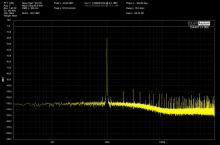 |
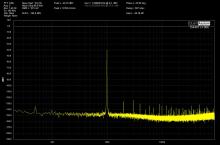 |
This section turned out worse, but it's still within 0.3 dB of target attenuation.
RMS to DC converter adjustment
RMS to DC converter is adjusted via RV4 and RV6 at two voltage points: 1V RMS and 0.1V RMS. I've set up both signal generators on my AD2, one for 1V RMS, another for 0.1V RMS. Both generators were checked and adjusted on QA401 so that their output level was as close to the desired values as possible.
Switching back and forth between two generators I adjusted potentiometers so that DC output tracked these levels asclose as I could get. Here's the table summary of the RMS to DC converter performance (QA401 values taken as a reference).
| Input voltage, pk | RMS (QA401) | RMS (RMS/DC) | Deviation, % |
|---|---|---|---|
| 20 mV | 14.0 mV | 14.5 mV | 3.57 |
| 50 mV | 35.1 mV | 35 mV | 0.28 |
| 100 mV | 70.4 mV | 70 mV | 0.57 |
| 200 mV | 140 mV | 140 mV | 0 |
| 400 mV | 281 mV | 282 mV | 0.36 |
| 600 mV | 422 mV | 423 mV | 0.24 |
| 800 mV | 563 mV | 564 mV | 0.18 |
| 1.0 V | 704 mV | 706 mV | 0.29 |
| 1.2 V | 845 mV | 847 mV | 0.24 |
| 1.4 V | 985 mV | 989 mV | 0.41 |
| 1.6 V | 1.12 V | 1.13 V | 0.89 |
| 1.8 V | 1.26 V | 1.27V | 0.79 |
| 2.0 V | 1.40 V | 1.41 V | 0.71 |
| 2.2 V | 1.54 V | 1.55 V | 0.65 |
| 2.4 V | 1.69 V | 1.70 V | 0.59 |
| 2.6 V | 1.83 V | 1.84 V | 0.55 |
| 2.8 V | 1.97 V | 1.98 V | 0.51 |
| 3.0 V | 2.11 V | 2.12 V | 0.47 |
| 3.2 V | 2.25 V | 2.26 V | 0.44 |
| 3.4 V | 2.39 V | 2.40 V | 0.42 |
| 3.6 V | 2.55 V | 2.54 V | 0.39 |
| 3.8 V | 2.69 V | 2.66 V | 0.81 |
| 4.0 V | 2.83 V | 2.77 V | 2.12 |
It is clearly seen that the working range is from 20 mV RMS to 2.5V RMS where average deviation is less than 1%.
LOG output adjustment
LOG converter is adjusted via RV1 and RV2 at two voltage points: 0 dBV and -60 dBV. This is a perfect case for our attenuator box. I've set up a signal generators on my AD2 to get precisely 0 dBV out and fed it into the converter input. After adjusting both trimmers as per instruction I run a quick test of the log converter performance (note that the converter scale is -10 mV/dB):
| Input voltage, dBV | LOG out | Error, % |
|---|---|---|
| 0 | 0 mV | 0 |
| -20 | -199.6 mV | 0.2 |
| -40 | -399.3 mV |
0.18 |
| -60 | -600 mV | 0 |
| -80 | -798 mV | 0.25 |
Again, we can see excellent results - less than 0.5% on the 80 dB range.
I was planning to describe the low noise preamp adjustments here, but the post is getting quite long already, so this part will have to wait till the next time.
